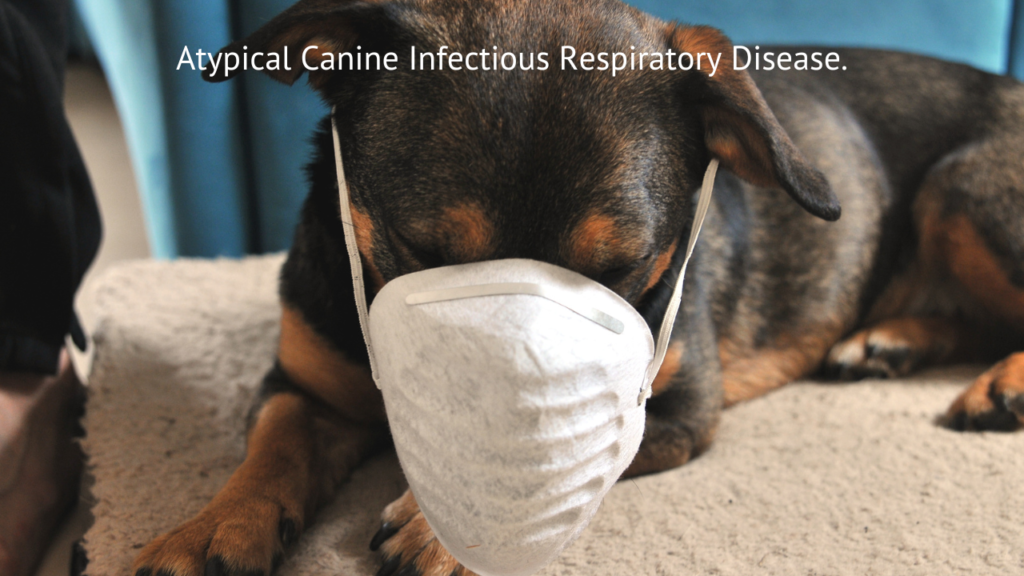aCRID is a new bacterial infection that causes severe respiratory symptoms in dogs, such as coughing, sneezing, fever, and pneumonia. It is caused by a new strain of Bordetella bronchiseptica, a common bacterium that also causes kennel cough. aCRID was first reported in the U.S. in late 2023, and has since spread to several states and countries. It is very difficult to treat and prevent, as the bacterium is resistant to most antibiotics and there is no vaccine available.

Table of Contents
Togglewhat is aCRID?
CIRDC stands for Canine Infectious Respiratory Disease Complex. It is a general term for a group of respiratory infections that affect dogs, often known as kennel cough. CIRDC can be caused by various viruses and bacteria, such as canine parainfluenza virus, canine adenovirus type 2, canine distemper virus, canine influenza virus, canine respiratory coronavirus, canine pneumovirus, Bordetella bronchiseptica, Streptococcus zooepidemicus, and Mycoplasma cynos . CIRDC usually causes mild symptoms, such as coughing, nasal discharge, and ocular discharge, but can sometimes lead to more serious complications, such as pneumonia and sepsis. CIRDC is highly contagious and can spread through direct contact, aerosols, and fomites. CIRDC can be prevented by vaccinating dogs against some of the common pathogens and avoiding exposure to infected dogs.
aCRID stands for Atypical Canine Infectious Respiratory Disease. It is a new bacterial infection that causes severe respiratory symptoms in dogs, such as coughing, sneezing, fever, and pneumonia. It is caused by a new strain of Bordetella bronchiseptica, a common bacterium that also causes kennel cough. aCRID was first reported in the U.S. in late 2023, and has since spread to several states and countries. It is very difficult to treat and prevent, as the bacterium is resistant to most antibiotics and there is no vaccine available.
Difference between aCRID and CIRDC(Kennel Cough)
| Feature | aCRID | Kennel Cough |
|---|---|---|
| Cause | A new strain of Bordetella bronchiseptica | Various viruses and bacteria, such as canine parainfluenza virus, canine adenovirus type 2, canine distemper virus, canine influenza virus, canine respiratory coronavirus, canine pneumovirus, Bordetella bronchiseptica, Streptococcus zooepidemicus, and Mycoplasma cynos |
| Symptoms | Difficulty breathing, coughing, sneezing, nasal and/or eye discharge, loss of appetite, lethargy, fever, pneumonia (in some cases) | Coughing, nasal discharge, ocular discharge (in some cases) |
| Treatment | Supportive care, hydration, oxygen therapy, cough suppressants, antibiotics (if bacterial infection is suspected) | Supportive care, hydration, cough suppressants, antibiotics (if bacterial infection is suspected) |
| Prevention | Avoid contact with infected dogs, isolate sick dogs, practice good hygiene and sanitation | Vaccinate dogs against some of the common pathogens, avoid contact with infected dogs, isolate sick dogs, practice good hygiene and sanitation |
| Vaccine | No | Yes, for Bordetella bronchiseptica |
| Mortality rate | 18.7% in the U.S. in 2023 | Low, unless complicated by pneumonia or sepsis |
Symptoms of aCRID:
- Difficulty breathing
- Coughing
- Sneezing
- Nasal and/or eye discharge
- Loss of appetite
- Lethargy
- Fever
- Pneumonia (in some cases)

How can I protect my dog from aCRID?
The best way to protect your dog from aCRID is to avoid contact with infected dogs, isolate sick dogs, and practice good hygiene and sanitation. You can also vaccinate your dog against other respiratory pathogens, such as canine influenza and parainfluenza, to reduce the risk of co-infection. However, there is no vaccine for aCRID, so you should monitor your dog for signs of respiratory illness and seek veterinary care if needed.
Here’s a step-by-step guide on how to protect your dog from aCRID:
- Minimize your pet’s contact with other dogs, especially in crowded places like dog parks and daycares. aCRID may spread through respiratory droplets and aerosols from coughing and sneezing by infected dogs or direct contact with contaminated objects.
- Avoid communal water and food bowls, as they may harbor the bacteria that causes aCRID1. Provide your pet with clean and fresh water and food daily, and wash the bowls regularly.
- Isolate your pet in a separate room if it shows signs of aCRID, such as difficulty breathing, coughing, sneezing, nasal and/or eye discharge, loss of appetite, and lethargy. Remove any shared bowls, beds, and toys from the room, and disinfect them thoroughly.
- Contact your veterinarian as soon as possible if your pet has symptoms of aCRID. Early diagnosis and supportive care may improve the outcome of the disease. Your veterinarian may prescribe a combination of drugs, such as azithromycin and doxycycline, to try to control the infection.
- Wash your hands thoroughly after handling your pet or other dogs, and wear gloves and a mask if possible. Although there is no evidence of aCRID transmission to humans, it is better to be safe than sorry, as the cause of the disease is still unknown.
Is there any cure to aCRID?
Unfortunately, there is no specific cure for aCRID, as the cause of the disease is unknown. The only treatment available is supportive care, which may include hydration, oxygen therapy, cough suppressants, and antibiotics (if bacterial infection is suspected). In severe cases, hospitalization might be necessary. The success rate of the treatment is low, and some dogs may not respond to any treatment.
Guide for aCRID Patient Owners:
If due to the contact of any other animal or due to any possible mode through which this virus spreads, affects your dog. Here is a simple guide which you can follow for personal care of the dog. However, this is not a substitute for professional veterinary advice, and you should consult your veterinarian for its required medical treatment.
| Step | Name | Description |
|---|---|---|
| 1 | Isolation | Isolate your pet in a separate room and remove any shared bowls, beds, and toys from the room. Disinfect them thoroughly before using them again. |
| 2 | Diagnosis | Contact your veterinarian as soon as possible and follow their instructions. Your veterinarian may prescribe a combination of drugs, such as azithromycin and doxycycline, to try to control the infection. |
| 3 | Treatment | Provide your pet with supportive care, such as hydration, oxygen therapy, cough suppressants, and antibiotics (if bacterial infection is suspected). In severe cases, hospitalization might be necessary. |
| 4 | Monitoring | Monitor your pet’s condition and watch for signs of improvement or worsening. If your pet develops pneumonia or sepsis, the prognosis is poor and the risk of death is high. |
| 5 | Prevention | Wash your hands thoroughly after handling your pet or other dogs, and wear gloves and a mask if possible. Although there is no evidence of aCRID transmission to humans, it is better to be safe than sorry, as the cause of the disease is still unknown. |
How long does it take for a dog to recover from aCRID?
The recovery time for a dog with aCRID depends on the severity of the infection and the response to the treatment. Some dogs may recover within a few weeks, while others may take months or never fully recover. The prognosis is poor for dogs that develop pneumonia or sepsis, as they have a high risk of death. Therefore, it is important to seek veterinary care as soon as possible if your dog shows signs of aCRID.
Can dogs get reinfected with aCRID?
Yes, dogs can get reinfected with aCRID, as the infection does not confer long-lasting immunity. A study from India found that 4.5% of SARS-CoV-2 infected individuals experienced reinfection after an interval of at least 102 days. Although aCRID is caused by a different strain of Bordetella bronchiseptica, a bacterium that is specific to dogs, it may have similar reinfection patterns as SARS-CoV-2, which is also a respiratory pathogen. Therefore, dog owners should be vigilant and monitor their dogs for signs of respiratory illness, even if they have recovered from aCRID before.
General FAQs on aCRID
What is aCRID? aCRID is a new bacterial infection that causes severe respiratory symptoms in dogs, such as coughing, sneezing, fever, and pneumonia. It is caused by a new strain of Bordetella bronchiseptica, a common bacterium that also causes kennel cough. aCRID was first reported in the U.S. in late 2023, and has since spread to several states and countries. It is very difficult to treat and prevent, as the bacterium is resistant to most antibiotics and there is no vaccine available.
How does aCRID spread? aCRID may spread through respiratory droplets and aerosols from coughing and sneezing by infected dogs or direct contact with contaminated objects. The disease is highly contagious and can affect dogs of any age, breed, or health status.
What are the symptoms of aCRID? The symptoms of aCRID are:
Difficulty breathing
Coughing
Sneezing
Nasal and/or eye discharge
Loss of appetite
Lethargy
Fever
Pneumonia (in some cases)
These symptoms may last for six to eight weeks or longer, and may not respond well to antibiotics. If you notice these signs in your dog, you should contact your veterinarian immediately.
How is aCRID diagnosed? The diagnosis of aCRID is challenging, as there is no specific test for the disease. Veterinarians may use a combination of methods, such as culture, PCR, and serology, to diagnose the infection based on the presence of the bacterium or its antibodies in the dog’s samples. However, these tests may not be widely available or reliable, and may take several days to get the results.
How is aCRID treated? The treatment of aCRID is also difficult, as the bacterium is resistant to most antibiotics. Veterinarians may prescribe a combination of drugs, such as azithromycin and doxycycline, to try to control the infection. However, the success rate is low, and some dogs may not respond to any treatment. The only treatment available is supportive care, which may include hydration, oxygen therapy, cough suppressants, and antibiotics (if bacterial infection is suspected). In severe cases, hospitalization might be necessary.
How can aCRID be prevented? The prevention of aCRID is limited, as there is no vaccine for the disease. The best way to prevent aCRID is to avoid contact with infected dogs, isolate sick dogs, and practice good hygiene and sanitation. You can also vaccinate your dog against other respiratory pathogens, such as canine influenza and parainfluenza, to reduce the risk of co-infection. However, these vaccines may not protect your dog from aCRID, as the disease is caused by a new strain of Bordetella bronchiseptica.
Can humans get infected with aCRID? There is no evidence that humans can get infected with aCRID, as the disease is caused by a new strain of Bordetella bronchiseptica, a bacterium that is specific to dogs. However, some researchers have suggested that Alzheimer’s disease, a form of dementia in humans, may be transmissible through rare medical accidents involving contaminated human tissue . This is not related to aCRID, but it shows that some diseases may have unexpected modes of transmission.

